The Moundbuilders
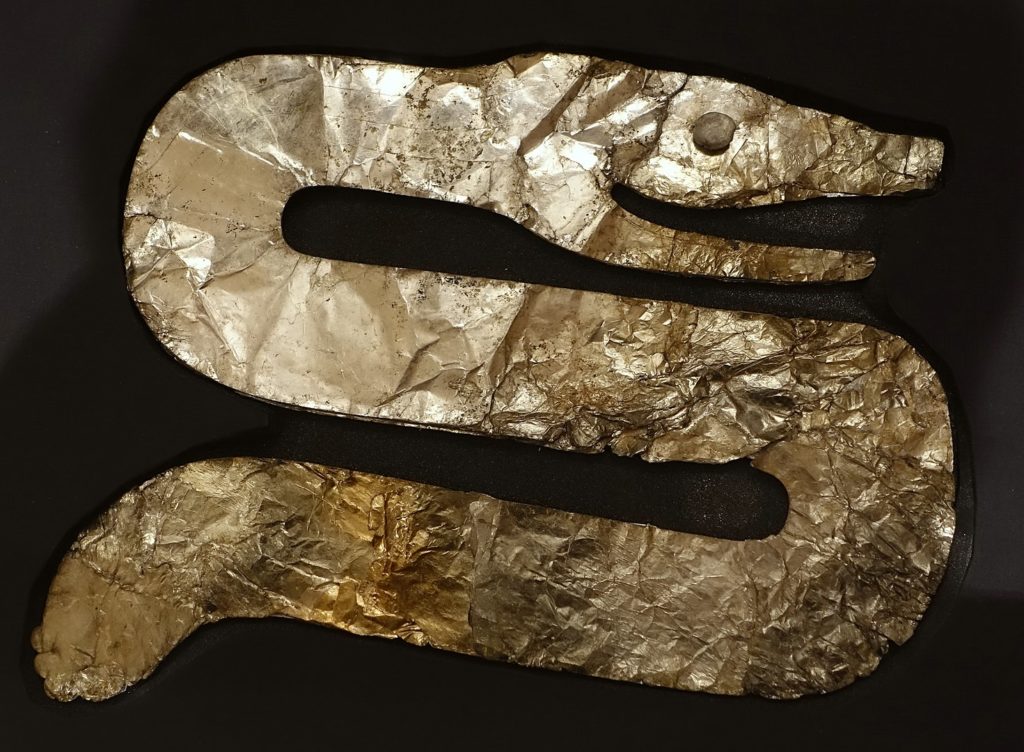
Serpent effigy, Turner Group, Mound 4, Little Miami Valley, OH by Daderot is licensed under public domain.
When I reached the foot of the principal mound, I was struck with a degree of astonishment, not unlike that which is experienced in contemplating the Egyptian pyramids. What a stupendous pile of earth!
—Henry Marie Brackenridge to Thomas Jefferson, on encountering the remains of Cahokia
p>Thousands of prehistoric earthen mounds are known throughout the Mississippi and Ohio River basins and throughout the southeastern United States. The people who built these earthen mounds are known collectively as the Moundbuilders, but they were by no means a distinct and unified culture. The Hopewell Tradition (ca. 100 BC-AD 500) refers to a large network of trade and exchange connected by a similar belief system. The Hopewell tradition encompassed a huge area of disparate peoples across what is today the eastern United States. However, these groups shared a religious ideology, or belief system, as evidenced by similar burial practices and symbolic prestige goods. Hopewell Hopewell earthworks, monuments made of earth, include enclosures, and processionals (parallel mounds connecting enclosures). Hopewell enclosures appear to have been sacred spaces rather than defensive works. Habitation sites (where people lived) were located away from enclosures and burial mounds.
Another moundbuilder culture (there were several) called the Effigy Mound Culture built effigy mounds or mounds in the shape of animals. Serpent Mound, the largest effigy work in the world, is 1,330 feet long and three-foot high. Serpent Mound dates somewhat later than the Hopewell but is one of the most famous examples of a Moundbuilder earthwork. Like many spectacular archaeological sites, it has seen its share of abuse. Frederic Putnam, an early advocate for preservation, wrote in 1886:
Hundreds of persons visit the place every year, and among them have been vandals who have dug into the embankment and left unfilled the holes they made. As a consequence, the rains, and the trampling of cattle and visitors, have caused such places to wear away and thus seriously injure this sacred work, the only one of its kind.
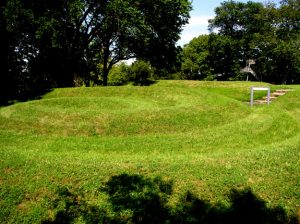
Serpent Mound Spiral. Hieronymous Rowe at English Wikipedia [CC BY-SA 3.0 http://creativecommons.org/licenses/by-sa/3.0) or GFDL (http://www.gnu.org/copyleft/fdl.html)], via Wikimedia Commons
The Hopewell tradition is also characterized by elaborate mortuary mounds in which the dead were
interred. Mortuary mounds increased in size as burials were added to a central burial mound. At least one study at the Hopewell Mound Group site in Ohio has looked at genetic relationships between people buried in the mounds. Mill’s work suggests that people buried in the mounds were not closely related, and share commonalities with diverse Native American tribes like Apache, Iowa, Micmac, Pawnee, Pima, Seri, Southwest Sioux, and Yakima. In addition to elaborate earthworks, the Hopewell tradition is characterized by prestige goods, items used by elites, and people with a disproportionate amount of wealth and power, which circulated over a wide area.
This extensive trade network is often referred to as the Hopewell Interaction Sphere, centered in the Scioto River Valley of south-central Ohio. Trade goods included copper from Lake Superior, obsidian from Yellowstone, Knife River flint from the Dakotas, pearls from the Ohio and Tennessee Rivers, shell from the Gulf and Atlantic coasts, and mica, steatite, and chlorite from the Appalachians. Hopewell trade networks obtained grizzly bear teeth and claws along with Knife River Flint from the Northern Plains. Obsidian from the Obsidian Cliffs source in Yellowstone National Park in Wyoming was traded as large biface blanks that were then finished into large ceremonial points. Sheets of mica, a mineral silicate that separates into sheets, from the southern Appalachian Mountains were cut into elaborate plaques that perhaps were used in public ceremonies to evoke connections to the supernatural and validate the ritual and political power of the bearer. Exotic Hopewell goods included artwork of copper from the Western Great Lakes. The copper was either cold hammered or annealed (heated then hammered) not smelted from ore. We’ll talk more about metalworking later in the semester.
Perhaps most interesting of all, are Hopewell platform pipes. Typically made from Ohio Pipestone, the pipes sometimes took the form of animals, with the figure facing the smoker. Most of the pipes, like most Hopewell prestige goods, have been recovered from burials. One interesting idea put forth by Robert Hall is that political leaders smoked tobacco in these pipes as part of ceremonies designed to mediate the interaction between different cultural groups participating in the Hopewell Interaction Sphere. These ceremonies might have been much like the historic Peace Pipe Ceremony, in which violence was forbidden when pipes, called calumets, were passed. This type of approach to understanding the past, where modern people are linked to past ones, is called the direct historical approach.
As with the later Peace Pipe Ceremony pipes, early Hopewell pipes were made in the form of weaponry, the atlatl. Also, many of the pipes are found in mortuary contexts and appear to have been deliberately broken. At first, this might seem an unusual practice, but ritually killing objects is quite common even today. In the American Southwest, certain pottery types were “killed” by drilling or punching a hole through the center and then placed over the deceased head. This ritual killing might have released the spirit associated with the object.
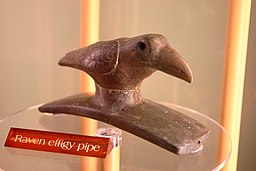
A Raven Effigy Pipe. rdikeman. Creative Commons Attribution-Share Alike 3.0 Unported
Vikings had a similar practice of killing swords by heating and bending them and burying them with the fallen warrior. The swords had powerful magical qualities and were thought to have been killed to avoid retribution. Even today in some cultures, pots and pans, shoes, and other personal objects of a loved one are destroyed and removed from the home to facilitate passage to the next world.
Hopewell exotic goods were probably made by craft specialists, people who produce more goods than they use for their own families. In more complex societies, there are often craft specialists who are devoted full-time to making goods. Craft specialization is an important concept in archaeology. It shows that some people are supported by others for their work as artisans. Secondly, the existence of prestige goods and the specialists that make them indicates at least some degree of social hierarchy, that is, some people have more power and prestige than others. While prestige goods may have been traded along the same routes as foodstuffs, exotic goods were likely exchanged between high-status political leaders only and eventually buried with them. Indeed, most Hopewell exotic goods occur in burials. Some Hopewell graves contain many exotic goods, while others are simple cremations, suggesting differences in status. Examination of differences in mortuary treatment is a key way that archaeologists make inferences about political structure, or who had power and made decisions. The high-status Hopewell burials are thought to have been leaders who gained prestige through their accomplishments, called achieved status. Children, who could only have inherited their status, are rarely found with elaborate grave goods. In later Moundbuilder cultures, the distinction between the powerful and the populace becomes even more distinct, as we will see. Leadership in these later cultures is thought to have been hereditary or inherited.
In addition to copper goods, stone tools are also found in high-status Hopewell burials. Large caches of extremely well-made bifaces—stone worked on two faces—and finished projectile points of high-quality raw materials are found in high-status Hopewell burials. More than 7,000 bifaces of high-quality Burlington chert were found in a single burial mound at Mound City. Obsidian from the Obsidian Cliffs source in Yellowstone National Park in Wyoming was traded as large biface blanks that were then finished into large ceremonial points. Obsidian from the Obsidian Cliffs source in Yellowstone National Park in Wyoming was traded as large biface blanks that were then finished into large ceremonial points. As with people living tens of thousands of years ago in the Upper Paleolithic, the Hopewell sought to distinguish themselves, and leaders in particular, with personal adornment. Elaborate copper pieces worn at the neck called gorgets, along with headdresses, earspools, and ceremonial celts set apart the political leaders from the populace. As we will see in later chapters, it is very common for elites to set themselves apart in terms of dress and even alter their biological features.
Hopewell Subsistence
The Hopewell phenomenon, with its monuments, long-distance exchange, craft specialization, and status differentiation was based largely on hunting and gathering. There were some native domesticates, like goosefoot and amaranth, but nothing nearly as productive as maize. Hopewell shows that social complexity (differences in wealth, specialization, monumental structures) can arise in primarily hunting and gathering cultures. Social complexity in hunting and gathering societies seems to be possible in environmental regions that are highly productive.
The Great Hopewell Road
In Frederic Putnam’s day, development and farming were destroying the mounds at an alarming rate, and he began to raise funds to purchase the sites like Serpent Mound to preserve it. Journalist Ephraim Squier and physician Edwin Davis began a large-scale survey of mounds in the Ohio Valley and created maps of mounds that are still used today. Much was lost, however, and we will never know the full scale of the Hopewell. Technology, however, has revealed some surprising traces of the Hopewell. Bradley Lepper read early descriptions of Hopewell earthen enclosures and noticed a reference to a causeway or road. The road was essentially bounded by two parallel earthen banks 150 feet apart. Investigating, he noticed traces of these parallel lines of aerial photos from the 1930s that could have joined two separate major Hopewell ceremonial centers, Newark and Chillicothe, which are sixty miles apart. He calls this The Great Hopewell Road. More recent technology called LiDar, Light Detecting and Ranging, uses lasers to map the surface of the Earth and can reveal subtle features not detectable with the naked eye. LiDar has been used to help try to track the course of the Great Hopewell Road. Ceremonial roads like this one, as we will see, are quite common in the human past and have been discovered in Neolithic England, the American Southwest, Mesoamerica, and other archaeological cultures.
The Great Moundbuilder Debate
Who built the mounds? By the early 1800s, two models were developed to account for these earthen mounds. The Lost Race Model contended that the mounds were constructed by a “lost race” of non-Indians that was displaced by more recent Indians. Others suggested the moundbuilders left to become the splendid Maya or Aztecs to the South. The natives who occupied the area at the time were thought to have driven out this spectacular culture. Remember that it was George McJunkin, the discoverer of the Folsom site, who changed that story forever. The Native Model contended that the ancestors of recent Native American Indians made the mounds. You will learn in this week’s video how this debate played out.
The Mississippian
The Mississippian Moundbuilder culture occurs well after the Hopewell around AD 800–AD 1500. Well-known Mississippian sites include Moundville in Alabama, Spiro Mounds in Arkansas, and Cahokia in Illinois. While maize appeared perhaps as early as 100 BC in Florida and its use was widespread throughout the east by AD 400, it did not become the primary staple crop in the eastern part of the United States until around AD 800. Remember that maize was first domesticated in central highland Mexico, and had to travel to North America. Maize agriculture tied people to land and created the opportunity for large food surpluses, urban centers, and dense populations. Surplus production allowed segments of the population to be freed from agriculture and provided the potential for differences in wealth and status. The frequency of the stone hoes and stone-lined storage pits indicates that reliance on intensive maize agriculture and food storage became more important during the Mississippian period. Cahokia, a World Heritage Site in modern-day Illinois, just east of East St. Louis, became the largest prehistoric city north of Mexico—perhaps the only true city north of Mexico. Once regarded as a mostly empty ceremonial center, it is today regarded as a true city, as big in its day as London. The site is located in the fertile Mississippi floodplain called the American Bottom and was a hub of exchange, with flat-topped mounds, fortifications, planned settlements, and a definite social hierarchy, in which some
people were afforded higher social status. Cahokia was at its height between AD 1050 and 1300, with more than 100 earthen mounds in an area of 5 square miles. While maize supported the Cahokian economy, the diet was supplemented by wild turkey, aquatic resources, and local plants. At least 25 mounds were completely leveled, including the second largest, during the founding of St. Louis, and so archaeologists will never have the full picture of the scale of this city. Cahokia Beginnings: Alternative Views Cahokia archaeologist Timothy Pauketat, notes that the construction of Cahokia began abruptly in the AD 1050s, near the time of the 1054 supernova which could be seen in daytime near the crescent moon for 23 days. The celestial event was recorded by Chinese astrologers. Pauketat suggests that this event may have been viewed symbolically and caused the “big bang” of Cahokia. Others object to the idea that a symbolic event can produce such a major change and focus more on the productivity of the area and population growth as motivating factors. We see in action a contextual approach and ecological approach at odds.
The Central Precinct
The central ceremonial precinct at Cahokia called “downtown Cahokia” was surrounded by a palisade or wall enclosing approximately 200 acres. The palisade was made from wooden logs and mud and was rebuilt several times over 200 years. This central precinct acted like a gated community, with elite residences on top of platform mounds and ceremonial temple mounds located inside the palisade. Elites living atop the mounds were both socially above and physically above the general populace. This is not such an unusual idea. Early presidents of the United States atop “mounts” like Mount Vernon, Monticello, and Montpelier. Outside the palisade, the residences are more modest and likely housed the general populace. Residential hierarchy refers to differences in the location and elaboration of houses and is a useful indicator of social differences. The inner precinct also contained a ceremonial plaza. The palisade may have more than just a social barrier. It was built with upright logs set into a trench and then covered with a coating of clay, presumably to prevent burning by attackers. Though there is no evidence of invasion, the wall could have served defensive purposes.
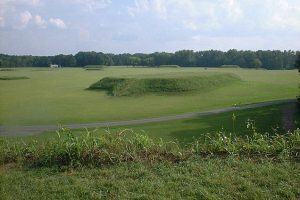
Moundville, Mississippi. Altairisfair. public domain.
The Mounds
As with the earlier Moundbuilder cultures, earthen mounds continued to be used for burials during
Mississippian times. In addition, new platform mounds were used for both elite residences as well as temple mounds. These platform mounds were used by people of high status. Public ceremonies were likely conducted atop the temple mounds to solidify the social status of high-ranking people.
The largest prehistoric structure north of Mexico, Monks Mound is 30 meters (c. 100 ft.) high and covers 14 acres at its base. Like the palimpsest of bison paintings at Altamira and the layers of occupation of tell Abu Hureyra, Monks Mound wasn’t created in a single episode. The mound was constructed in 14 stages between AD 600 and 1250 and supported several structures. Cahokians got the earth to build the mound by excavating an enormous borrow pit, which was later filled in with trash of all kinds which was still decaying when the excavation pit was opened (it apparently reeked). More than a million charred seeds from borrow pits filled with trash indicate they were smoking tobacco.
Today, you can actually climb to the top of Monk’s Mound. During excavation, lenses (lenticular-shaped deposits) of different colored sediment could be observed in the excavation profile in Monks Mound. Each lens represents a single basket load of earth carried by a laborer. Approximately 21 million cubic feet of earth were moved in the construction of Monk’s Mound.
Mound 72
Mound 72 at Cahokia sounds innocuous enough, but its contents reveal much about social hierarchy and religious beliefs at Cahokia. The mound is long and ridge-like and oriented to the rising sun at the winter solstice. Mound 72 was used repeatedly for elaborate burial rituals that included high-status people with abundant offerings accompanied by human sacrifices. A total of 261 burials spanning 100 years were recovered during the excavation of Mound 72. At the base of the mound, one male in Mound 72 was buried on a wooden litter—a stretcher-like platform. The skeleton lay on a bed of more than 20,000 shell beads that were once sewn onto a cape in the shape of a falcon. Below him was buried another male. The males were in shrouds indicating they may have died sometime before internment.
Associated with the caped male in Mound 72 were, young female human sacrifices, including a mass burial of 50 young women lined up on wooden litters. The victims were likely killed nearby and carried on the litters to a pit in the mound. These females do not show evidence of violent treatment. Looking at the carbon and nitrogen isotopes in these women’s skeletons compared to the high-status burials, it became clear that the women ate more maize and less meat than the central male figures. Corn is missing vital amino acids found in meat, and these women may have suffered from poor nutrition. Dental studies suggest they may not have even been from Cahokia proper. Historic accounts of the Natchez Indians, who also built earthen mounds, indicate that female relatives were sometimes strangled upon the death of a high-status male. In one account a French reported:
“The death of a chieftain touched off a sacrificial orgy when several aides and two of the man’s wives and three children were strangled so they could escort him into the next world.” (Indian Tribes of the Lower Mississippi Valley)
It is, therefore, possible that these women in Mound 72 might have been strangled wives or female kin of the deceased, which would have left no physical evidence of violent treatment on the skeleton. Other sacrifices occurred associated with the caped man along with mounds of grave goods. Some of the skeletons occurred in bundles, indicating that they had died much earlier, and subsequently placed in the pit. Charnel houses are places where the dead are interred to decompose, and the bones are later retrieved for burial or reuse. We saw a similar practice in the Neolithic where bodies were buried, then later re-excavated and the skull removed. The skulls were then used in other contexts and sometimes reburied in skull caches. Associated with the central caped male burial were mounds of grave goods. Caches of distinctive projectile points, arrowheads, of different styles, and different materials occur as grave offerings in Mound 72. Because of their similar orientation, the points were probably hafted onto arrow shafts when they were interred. Darker-tipped points pointed to the winter solstice sunrise while lighter-tipped points pointed to the summer solstice sunset. The orientation of other caches suggests the points were not hafted. The tri-notched projectile point of these caches is characteristic of the Cahokia region. The use of different styles and raw materials for the projectile points may indicate that mourners, perhaps subjects or allies, came from outlying areas to pay their respects to the deceased chief. Non-local point style from the Caddoan Mississippian (southwest of Cahokia) along with points made from an Arkansas black chert were discovered in Mound 72. The orientation of other caches suggests the points were not hafted. The tri-notched point is characteristic of the Cahokia region.
Mica flakes and shell disks were also burial offerings in Mound 72. Chunkey stones, historically used in the game of chunkey, also occur as burial offerings in Mound 72. In historic times, the chunkey stones would be rolled on edge down the playing field. Depending on the game, players would either throw their spears to where they thought the chunkey stone would fall over, with the closest player winning the round, or players try to knock the chunkey stone over with their spears. Like the Mesoamerican ballgame, the game of chunkey may have had both social and religious connotations. Large pipes depicting men about to roll the chunkey stone have been found at several Mississippian sites. You will read more about this game in this week’s readings.
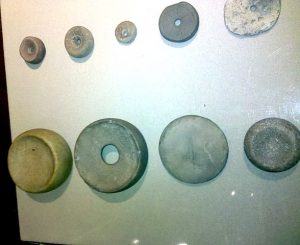
By Herb Roe, www.chromesun.com – Own work, CC BY-SA 3.0, https://commons.wikimedia.org/w/index.php?curid=11214315
Other high-status shrouded burials occur in the mound as well, including men, women, and children. Beneath these burials were more human sacrifices. These, unlike others, showed evidence of violent death, including decapitation, and were not carefully placed. This execution appears to have been conducted at the mound with the bodies falling into the pit. Finger bones dug into the fine white sand that lines the bottom of the pit, suggesting that some were not dead when buried. No offerings were associated with these individuals. In another pit, four males linked at the elbows were both beheaded and behanded. These people might have been enemy war captives slain to honor the passing of a high-status leader. Many other sacrifices occur in the mound as well as in surrounding mounds. Mississippian iconography at other sites reiterates themes of violence and human sacrifice. The Ramey Tablet is a sandstone tablet that has been interpreted as depicting a tree or rack with severed heads found in Mound 72. Images of skeletons with severed heads, severed heads alone, headless bodies, and fortifications are interpreted as evidence of warfare during Mississippian times. Ceramic vessels depicting apparent possible decapitated and tattooed heads also occur in the Mississippian. It is not clear, however, if they represent trophy heads, or honored dead.
Connecting past and present through historical connections, like the historical Natchez use of mounds and human sacrifice, is called the direct historical approach. The dramatic difference in burial elaboration along with clear evidence of human sacrifice is an indicator of differences in wealth and power in Cahokian society. Residential hierarchy, the central precinct, and burial distinctions indicate that some people had far more wealth and power than others. These distinctions are so pronounced, that status was almost certainly hereditary or inherited.
Several regional variants of later Mississippian culture were found in the eastern United States, from the eastern shore of the Atlantic to the margins of the plains. Each variant had different local forms of pottery, projectile points, and other material culture objects, but these were unified by common ritual iconography, which is sometimes referred to as the Southeastern Ceremonial Complex. SECC motifs include birds, hands, rattlesnakes, spiders, cats, stone maces, and death images. These motifs appear on shells, pottery, copper, and stone. The above image shows the hand-in-eye motif and intertwined rattlesnakes from Moundville, Alabama. The opposite side was concave and used for pigment grinding. Elaborated bifaces and maces are also found throughout the Mississippian and were likely symbols of power. Engraved shell gorgets and conch are expertly carved with symbols of the SECC. It has been suggested that the conch shells may have contained the so-called Black Drink made from holly leaves that was used historically in the American Southeast for ritual purposes. Recently, archaeologist Patty Crown at the University of New Mexico examined the organic residues absorbed into porous ceramic mugs or “beakers” from Cahokia and surrounding areas. The pores help preserve the residues from degradation. They used a technique called liquid chromatography. You’ll read this week about what she found. Today, 300,000 visitors visit Cahokia each year.